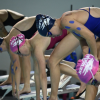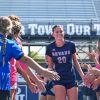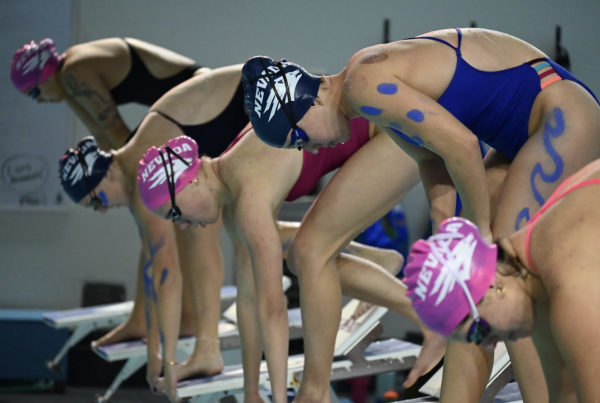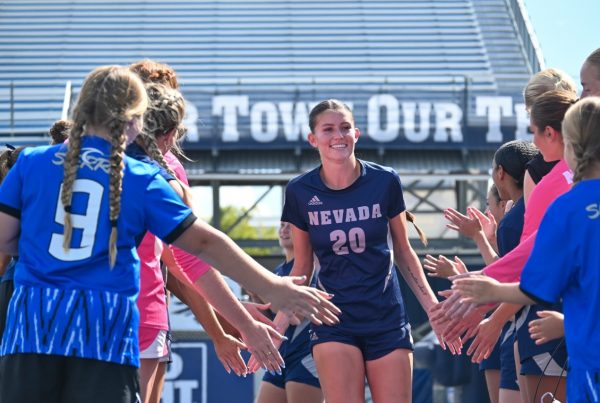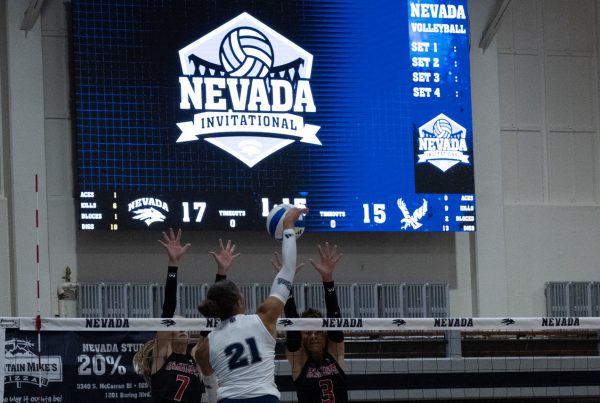
For much of the 2000s, Nevada’s football team consistently earned conference titles and bowl berths, including their famous win over Boise State in 2010. This success led Nevada to leave the Western Athletic Conference (WAC) for the Mountain West Conference (MWC) in 2012. Soon after, the WAC as it stood disappeared, and so did Nevada’s dominance with it. But what happened to the WAC? And why did Nevada have to leave it behind?
Chris Ault or “Coach” as he likes to be called, helped guide the Pack’s athletic program from a Division II independent in 1976 to a 1990s powerhouse. They became the first school to move up a division and win their conference in the same season by winning the Big West I-A title in 1992. In 1994 Nevada would lead the nation in passing.
The Wolf Pack is no stranger to realignment, having moved four times since Ault’s tenure began, with Nevada being a title contender in Division I-AA competing in the Big Sky Conference from 1979 to 1991.
“I loved it, this was my university, I was a graduate, my life was the university,” Ault said. “It was exciting and another gear for me.”
A move to the Big West in Division I-A, gave Nevada a chance to build up their men’s and women’s athletics programs – the latter of the two Ault said the Big Sky didn’t feature much of, as well as their rivalry with UNLV by playing them annually. The move occurred while Ault was serving double duty as coach and athletic director.
After eight years, another opportunity presented itself with the WAC seeking to replace lost schools in 2000. Commissioner Karl Benson invited Nevada while signing a TV rights deal with ESPN, giving the Pack more exposure than ever before.
Within the national footprint of the WAC, Nevada became more prominent locally.
“That was a big deal to me, that the community embraced it,” Ault said.
Women’s sports such as softball and soccer were started following the move, along with brand new facilities such as the Peterson Academic Center and the Primm Strength Center. Success came for the men’s basketball team as well, earning a trip to the Sweet 16 in 2004 after a WAC title. 2004 also saw Nevada’s athletic department bring home an All-Conference trophy, which they would repeat in 2007.
Women’s swim and dive has arguably been Nevada’s most consistent program, winning 11 conference titles dating back to 1979 and is one of only four sports to win a MWC title. They also boast the most All-Americans of any sport on campus.
Despite other programs flourishing thanks to the move to the WAC, football struggled, prompting a change in the leadership in the organization. Ault was mentioned as a name to help lead the Pack once again. Ault didn’t intend on returning to coaching, as he had been working solely as the athletic director since 1996, after serving as both coach and AD for nine years. However, Ault was swayed to rejoin Nevada once again in 2005.
“I was not considering it until president John Lilley approached me,” Ault said. “I had a lot of pride in the team.”
Once Ault returned to the sidelines in 2005, Cary Groth stepped in as athletic director. Groth had helped build Northern Illinois into a nationally known program through competitive scheduling. Their football team notched wins over Maryland and Alabama in the early 2000s.
“Plan the work and work the plan,” Groth said.
That was the motto she took with her from NIU to Nevada in hopes of building the school’s profile and resources.
“When I got there they were an FBS school, but hadn’t really made that jump,” Groth said.
The Football Bowl Subdivision (FBS) is the current division Nevada is in, which was formerly called Division I-A. Groth says Nevada mostly played a regional schedule, and wanted to start looking nationally. This included expanding their searches for coaches and recruits. Money was needed for these endeavors, prompting more donor outreach efforts to increase their budget.
As Nevada’s brand grew larger, new campus buildings and athletic facilities began to take shape during Groth’s tenure. These included the Hixson Softball Park and the IGT Knowledge Center. Heading into the 2010 season, the stars began to align for Nevada to make another move.
“When Boise made the decision to leave we knew we needed to,” Groth said. “We had outgrown it.”
Ironically, Boise State also helped Nevada move in another way, with their now famous 2010 football loss in Reno that eliminated them from national championship contention. It would be named “ESPN Game of The Year” and led Nevada to its highest ever national ranking at #11.
“That’s the greatest game the school’s ever won,” Ault said. “It put us at the highest viewpoint.”
Rory Hickok was hired the same year Nevada entered the WAC in 2000 to help run fundraising and scheduling. The move to the MWC required his expertise gained by serving under both Ault and Groth, who would eventually coordinate the move.
“We would have a conversation about ‘Alright let’s figure out things we need to do to get to the Mountain West,’” Hickok said. “We were already trying to put ourselves in the best possible position for several years prior to that announcement.”
That announcement came in 2010 when Nevada and Fresno State both agreed to join the MWC in 2012. Boise State had already left the WAC in 2011, triggering a wave of movement that eventually left the WAC with only two remaining schools from the 2010 season. The Mountain West had just lost three schools between the 2010 and 2011 seasons, leaving the door open for Nevada and others.
“She asked me at the time ‘If we’re going to make this move, we’re going to need to raise more money,’’’ Hickok said. “So we created this fundraising effort called ‘Battleborn’ and we generated one million dollars from about 50 donors.”
More fundraising efforts led to renovations of Mackay Stadium and other facilities, as well as offsetting increased travel costs within the larger conference. Additionally, Groth said there was “about a $2 to $2.5 million dollar” exit fee to pay the WAC in order to leave.
“We knew we would make it back in the first year,” Groth said.
Ultimately, many of Nevada’s old WAC and Big West rivals joined the Mountain West, which had been formed in 1999 with UNLV as a founding member. Rekindling the conference rivalry with UNLV was another important part of the move, allowing the two schools to create the “Governor’s Series” now known as the “Silver State Series,” counting every sport and academic matchup in a year-long competition.
Looking inside Legacy Hall, it is hard not to notice the great success Nevada had in the WAC, with many of their conference titles coming from that era. The Pack has struggled to win many conference championships since joining the MWC with only 10 total and none in the past two years. However, Hickok believes Nevada is still in a better place now.
“Without question, I think it elevated our athletic profile,” Hickok said. “It was easier to establish more rivalries by being in the Mountain West.”
At the time the WAC had both Louisiana Tech and Hawaii, making travel difficult at times compared to the Mountain West.
“It proved to be much better,” Groth said.
Meanwhile, the WAC went from a height of 16 members in the 1990s to only seven by 2013, and has continuously added and lost schools in the 12 years since Nevada’s departure. There are currently nine full time members remaining, but both Grand Canyon University and Seattle University will leave following the 2025 season. The WAC maintains affiliate members from the MWC in sports such as men’s soccer and swimming, but no longer offers football.
The most recent wave of realignment has torn apart the Pac 12 and part of the Mountain West, with many schools changing conferences in the last few years. Despite this, Ault believes Nevada is in a good place where it is now.
“Oh absolutely, because the Mountain West has some stability,” Ault said. “It is not the Pac 12 of old, it’s just another piece of the puzzle.”
In fact, Ault said it can be a good thing by having another western conference to schedule.
“The beauty of it is having another comparable conference,” Ault said.
Boise State and San Diego State had long been lobbying to join the Pac 12 and now will finally get their chance, albeit in a smaller version of the conference. As far as comparisons to the WAC’s situation, Groth says it is similar as “significant teams left, but the revenue is much different.”
“The public relations are much larger,” Groth said.
Following five of the Mountain West’s state universities moving to the Pac 12, it has added Hawaii full time after previously being football only and UTEP in all sports. Shortly after, Grand Canyon and UC Davis were brought in as non-football playing members, while NIU is joining for football only. This brings the conference to 10 full members by 2026. The Pac 12 will have eight members after adding Gonzaga University from the WCC. Although, Gonzaga does not play football, meaning that more potential Pac 12 moves could come.
While Nevada may not have the success it once had in the WAC where they won 20 championships (double their amount in the MWC), the additional revenue and closer competition provided by the Mountain West proved too good to pass up.




